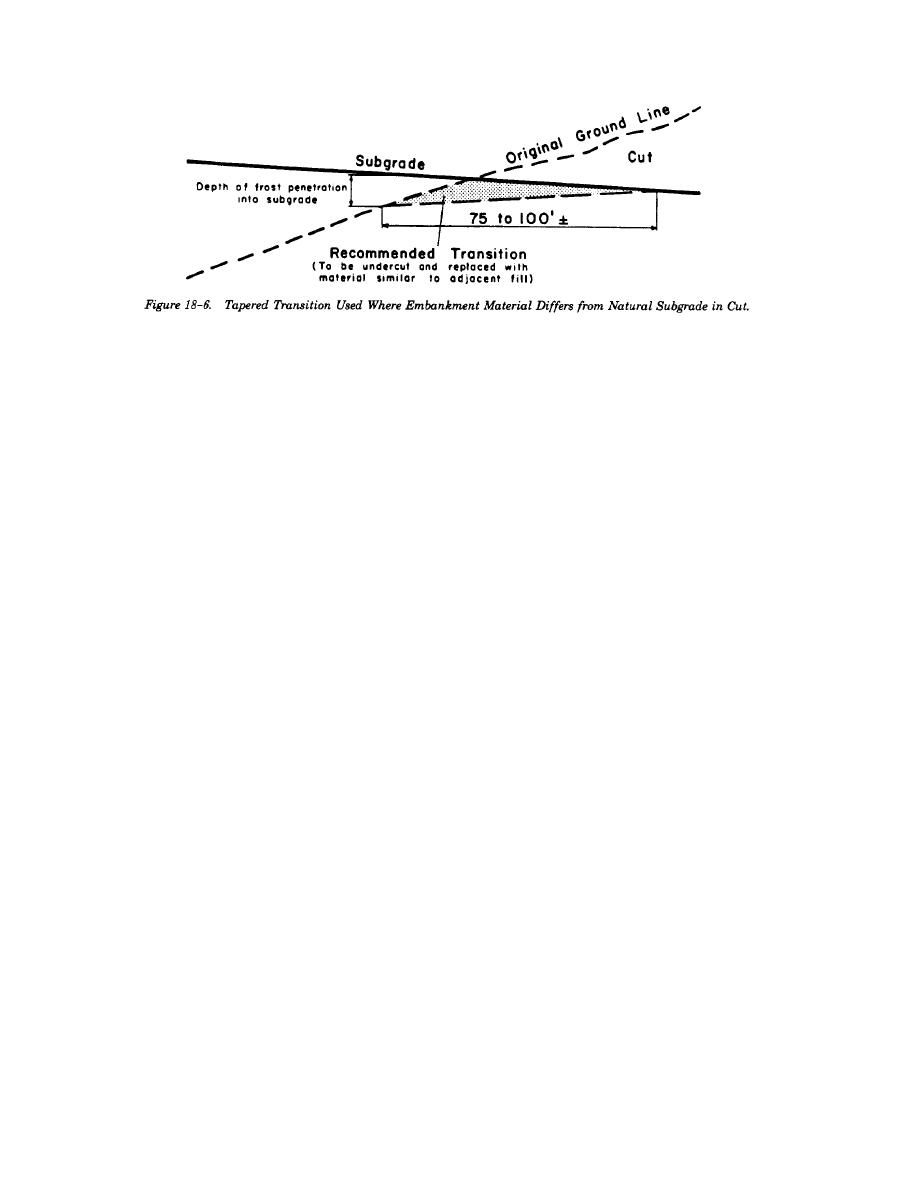
TM 5-822-5/AFM 88-7, Chap. 1
e. Wet areas. Careful attention should be given
18-18. Other Measures to Reduce Heave.
to wet areas in the subgrade, and special drainage
Other possible measures to reduce the effects of
measures should be installed as required. The need
heave are the use of insulation (appendix D) to
for such measures arises most frequently in road
control depth of frost penetration and the use of
construction, where it may be necessary to provide
steel reinforcement to improve the continuity of
intercepting drains to prevent infiltration into the
rigid pavements that may become distorted by frost
subgrade from higher ground adjacent to the road.
heave. Reinforcement will not reduce heave nor
f. Rock excavation. In areas where rock excava-
prevent the cracking resulting from it, but it will
tion is required, the character of the rock and
help to hold cracks tightly closed and thus reduce
seepage conditions should be considered. In any
pumping through these cracks. Transitions between
case, the excavations should be made so that posi-
cut and fill and culverts and drains change in
tive transverse drainage is provided, and no pockets
character or stratification of subgrade soils.
are left on the rock surface that will permit ponding
Subgrade preparation and boulder removal should
of water within the depth of freezing. The irregular
also receive special attention in field construction
groundwater availability created by such conditions
control.
may result in markedly irregular heaving under
freezing conditions. It may be necessary to fill
18-19. Pavement Cracking Associated with
drainage pockets with lean concrete. At
Frost Heave.
intersections of fills with rock cuts, the tapered
One of the most detrimental effects of frost action
transitions mentioned above (fig 18-6) are essential.
on a pavement is surface distortion as the result of
Rock subgrades where large quantities of seepage
differential frost heave or differential loss of
are involved should be blanketed with a highly
strength. These may also lead to random cracking.
pervious material to permit the escape of water.
Deterioration and spalling of the edges of working
Frequently, the fractures and joints in the rock
cracks are causes of uneven surface conditions and
contain frost-susceptible soils. These materials
sources of debris. Cracking may be reduced by con-
should be cleaned out of the joints to the depth of
trol of such elements as base composition, uni-
frost penetration and replaced with nonfrost
formity and thickness, slab dimensions, subbase and
susceptible material. If this is impractical, it may be
subgrade materials, uniformity of subsurface
necessary to remove the rock to the full depth of
moisture conditions, and, in special situations, by
frost penetration.
use of reinforcement and by limitation of pavement
g. Rock subgrades. An alternative method of
type. The importance of uniformity cannot be
treatment of rock subgrades, in-place fragmenta-
overemphasized. Where unavoidable discontinuities
tion, has been used effectively in road construction.
in subgrade conditions exist, gradual transitions are
Blast holes 3 to 6 feet deep are commonly used.
essential.
They are spaced suitably for achieving thorough
fragmentation of the rock to permit effective
18-20. Control of Subgrade and Base Course
drainage of water through the shattered rock and
Construction.
out of the zone of freezing in the subgrade. A ta-
Personnel responsible for field control of pavement
pered transition should be provided between the
construction in areas of seasonal freezing should
shattered rock cut and the adjacent fill.
give specific consideration to conditions and mate-
18-18



 Previous Page
Previous Page
